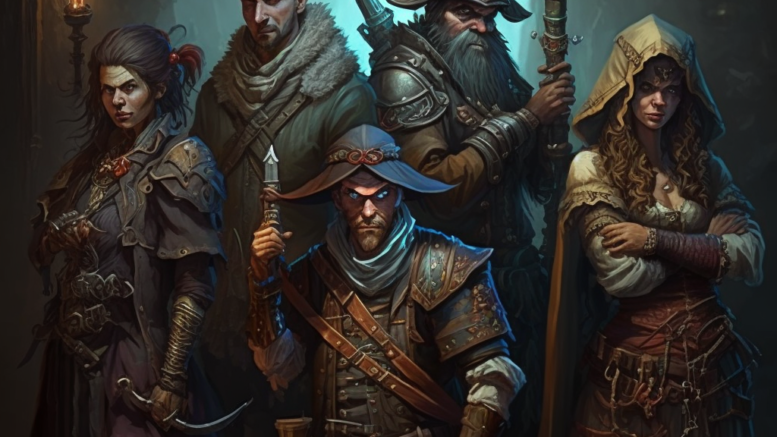Playing a rogue in both Dungeons and Dragons 5th edition (D&D 5e) and Pathfinder 2nd edition (PF2) can be a lot of fun, but there are also some important differences to consider when choosing between the two games.
One of the main pros of playing a rogue in both D&D 5e and PF2 is the class’s versatility. Rogues are skilled in stealth and deception, making them excellent at sneaking into places and stealing items. They also have a wide range of skills that allow them to excel in various roles, such as lockpicking, trap disarming, and pickpocketing. In addition, they have access to a variety of weapons and can deal significant damage in combat. For example, in D&D 5e, a rogue can choose to specialize in finesse weapons like rapiers and daggers, while in PF2, a rogue can choose to specialize in ranged weapons like shortbows and crossbows.
In both games, the rogue class also has a unique class feature called “sneak attack,” which allows them to deal extra damage when attacking a surprised or unaware opponent, making them a formidable force in combat. In D&D 5e, rogues have access to special abilities called “roguish archetypes,” which allow them to specialize in specific areas, such as thievery or assassination. One example of a roguish archetype in D&D 5e is the Thief archetype which grants the rogue the ability to move more stealthily and pick locks and pockets more efficiently. In PF2, they have access to special abilities called “roguish talents,” which serve the same purpose. One example of a roguish talent in PF2 is the Fast Hands talent which allows the rogue to use a swift action to disarm a trap or open a lock.
However, there are also some cons to playing a rogue in both games. One of the main cons is that the class is not as durable as other classes. They have fewer hit points and less armor, making them more vulnerable in combat. They also have limited spellcasting abilities, which can be a disadvantage if the player is looking for a character that can cast spells. This can make them less suitable for players who want to play a character that can take a lot of hits and keep on fighting.
When it comes to the nuance of each game, D&D 5e is known for its simplicity and ease of use. It’s a game that is straightforward and easy to pick up, making it a good choice for new players. One of the examples of the simplicity in D&D 5e is the proficiency system, where a character only needs to roll a d20 and add their proficiency bonus to determine if they succeed in a skill check. In contrast, PF2 has a bit more complexity and depth, and it’s geared towards experienced players who want more options and flexibility. For example, PF2 rogue class has more skill choices and more skills to choose from. Also, in PF2, characters get more abilities and options as they level up, allowing them to tailor their character to their preferred playstyle.
In conclusion, both D&D 5e and PF2 offer a lot of options for players looking to play a rogue. Both games feature versatile characters that are skilled in stealth and deception, and can deal significant damage in combat. However, they are not as durable as other classes and have limited spellcasting abilities. D&D 5e is known for its simplicity and ease of use, while PF2 offers more complexity and depth for experienced players. It’s ultimately up to the player to weigh the pros and cons and choose the game that best suits their preferences and experience level. For example, a new player might prefer D&D 5e for its simplicity and ease of use, while an experienced player might prefer PF2 for its depth and flexibility.
One example of how the nuance of each game can affect the rogue class is in the way traps are handled. In D&D 5e, a rogue can use their proficiency in thieves’ tools to disarm traps, but in PF2, traps are handled differently. PF2 has a separate skill for trapfinding and trap disarmament, and the rogue class has access to a wide range of talents that can be used to improve their trapfinding and trap disarmament abilities. This allows the rogue to specialize in this area, making them an even more valuable member of the party when it comes to navigating dangerous areas.
Another example is in the way of stealth and deception. In D&D 5e, the rogue class has access to the “sneak attack” ability, which allows them to deal extra damage when attacking surprised or unaware opponents. In PF2, the rogue class has access to a wide range of talents that can be used to improve their stealth and deception abilities, such as the “Sneak Attack” and “Deception” talents. This allows the rogue to specialize in these areas, making them even more effective at sneaking into places and stealing items.
Ultimately, it’s up to the player to decide which game and class best suits their preferences and playstyle. Both D&D 5e and PF2 offer a lot of options for players looking to play a rogue, and each game has its own unique set of pros and cons. D&D 5e is known for its simplicity and ease of use, while PF2 offers more complexity and depth for experienced players. It’s important to consider the nuances of each game and how they will affect the rogue class when making a decision.
What are your thoughts on the rogue class? Please share your thoughts in the comment section, I promise that I do read it 😉

Be the first to comment on "Dungeons and Deception: A Study of Rogue Play in D&D 5e and Pathfinder 2e"